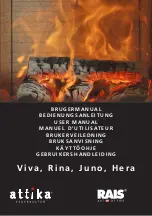
CLEO COMBI
.
24
8192000 Rev.08 – EN
6.1.
POSITION OF THE CHIMNEY CAP
The draught of the flue depends also on the suitability of the chimney cap.
It is therefore indispensable that, if built by an artisan, the outlet section is more than twice the internal section of the
flue.
As it must always exceed the roof ridge, the chimney cap must ensure exhaust even in the presence of wind (Picture
4).
The chimney cap must comply with the following requisites:
•
it must have an internal section equivalent to that of the chimney.
•
it must have useful section double that of the inside of the flue.
•
it must be built in a way to prevent the penetration of rain, snow and any other foreign body into the flue.
•
it must be easy to inspect, for any maintenance and cleaning operations.
Picture 4
Picture 5
Picture 6
Picture 7
(1) Industrial chimney
cap
with
pre-
fabricated elements,
allows
excellent
disposal
of
combustion gas.
(2) Artisan chimney cap.
The correct outlet
section
must
be
minimum 2 times the
internal section of the
flue, ideally 2.5 times.
(3) Chimney cap for flue in
steel with combustion
gas deflector cone
inside.
50 cm
(1) In the case of flanked flues, one chimney cap must be
higher than the other by at least 50 cm in order to prevent
the transfer of pressure between the flues themselves.
(1) The chimney cap must not have obstacles within 10 m from
walls, slopes and trees. If this is not the case, raise the same
by at least 1 m over the obstacle.
The chimney cap must pass the roof ridge by at least 1 m
2 m
10 m
1
m
>
_
A
>A
0,5 m
H min.
α
(2)Tetto
(1)Asse colmo
(1) ridge axis
(2) roof
















































